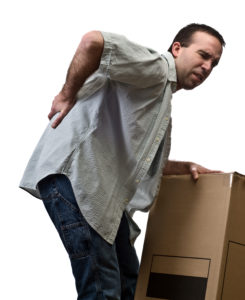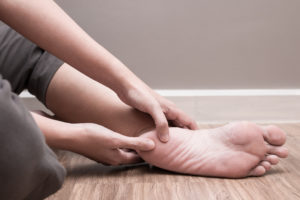
Whether through personal choice or by outside influence, there comes a time (or many) in our adult lives when we are responsible for moving our physical being and belongings into a new space. As the snail leaves behind her shell or the snake his skin, moving homes is a symbol of massive transition: both in the metamorphic sense and physical sense.
As I recently experienced, this is a transition you want to be physically prepared to take on.
Last month, my husband and I moved across the country. After eight years of making a comfortable home in California, we packed up our belongings and headed east. As a yoga teacher and movement educator, I couldn’t help but appreciate the many physically challenging movements that I encountered while transitioning homes. However, even in the midst of my appreciation, I noticed that there were some not-so-opportunistic muscles that were bothered during the big move.

The physical reality of packing, cleaning and hauling away your most precious belongings demands so much of your body. Knowing the high-risk zones will help you be prepared for the physical act of your own big moves.
So following are three of the bodily areas that are the most vulnerable during a move, and why.
1. Lower Back Pain and Strain
The most obvious and ominous area of my body that needed preparation was my back. Particularly the lower back. As I squatted, twisted and side-bended while reaching for big bulky cabinets, boxes and bureaus, the condition of my spinal muscles and hip stabilizers were put to the test.
Further research brought me to realize that this is not uncommon: movements that place stress on your lower back, like lifting heavy objects and twisting to lift, often lead to lumbar muscle strains. A muscle strain is when you pull or tear muscle fibers. This happens when a muscle is stretched past its typical range of motion, or forced to suddenly strongly contract.
2. Grip Challenges to the Fingers and Hands
I also noticed how difficult it was for my hands to hold onto awkward shaped dressers and furniture edges. This was a result of not having enough strength in certain grip positions. Sometimes these little movers of the body do a lot more than we think!
Again, I found that injuries and breakage to the fingers (digits) and hands is one of the most common types of moving injuries. When you suddenly ask your hands to grip and stabilize in ways they aren’t used to, you put them at risk.
3. Very Vulnerable Feet and Toes
Then there were my fatigued feet. Sure there was the occasional stubbed toe because “hey, that box wasn’t supposed to be there!” or the accidental dropping of a book. (Broken toes are a real danger when moving due to dropping things on those exposed phalanges.)
Also, my feet were the foundation to literally every move I made. So after two weeks of day and night packing and preparing, my feet were exhausted. Yes, the soles of my feet felt sore. But to my surprise my toes underwent an unusual amount of gripping — resulting in tired toes and stiff feet.
Empower Your Transition by Training to Move
After a few days of this movement mayhem, I decided to incorporate some out of the box techniques in my fitness conditioning practice. I guess you could say I started training to move. I love a good functional movement practice and since awkward and unconventional movement is part of our human experience, why not practice it?
Plus, making big life transitions is hard enough without aches, pains and possible injuries that come with getting your stuff from here to there. Training to move is one way to bring more ease and personal empowerment to these intense times.
How about you? Making moves soon? If you plan on moving homes, or just rearranging furniture, stay tuned for my next post about how to condition your body for awkward moving positions. I’ll show you how to employ some of your main muscle movers to prevent manual handling injuries while moving from place to place.













As a frequent mover, I appreciate the attention to this subject! I’ve been careful with my low back– but the hands/ grip and attention to feet is SO necessary (as I’m noticing in my own body) with age. I’ve made it a point to give my hands and feet a little extra love — and when I do, it’s a game changer. Great reminder 🙂
Ah the aches and pains that accompany moving. I love the insights in this article, especially grip strength! Something so over looked yet important for securely grabbing awkward boxes and items. This article reminds us of the importance of movment variability and training in all the ways! Thanks for sharing.
I’ve moved so many times with a lot of aches and pain, especially my back. I never really put much thought into my hands and feet until I couldn’t grip something. Incorporating these functional movements around the time of a move is a great idea!
I often talk about lumbar spine when I talk about moving, and I often forget the grip! Nice remember!
What a great reminder to train for life movements and moves 🙂 We should all try to add awkward moving and untypical patterns to our workouts to strengthen our entire body, because real life is not only on a sagittal plane.
I have experienced this over and over not only through moves but because we homestead and have been building our house, barns etc for years we have a spurt of this activity every spring and fall when the weather is good and suddenly I experience all the soreness and aches of new movement.
It is important to think before you leap especially for something momentous like moving to a new location and if you can take the time out to prep your body by doing stretches and strengthening excercise especially for the back, then you can prevent strains and injuries . It’s better to move slowly and mindfully
Great summary! I look forward to reading about the specific training exercises you recommend to prevent injuries while moving. Thank you!
Nice article to help with the awareness of moving on the body physically but also mentally. Thinking about the physicality of moving and how to start incorporating yur workout into the process.
Thank you for the reminder! I’m moving in five days so I will certainly keep that in mind, especially the importance of the grip strengh on smaller muscles.
This is the total essence of “grip to core to floor”!! The main muscles that are at risk for injury are in the exact areas as this principle. I took YTU teacher Todd Lavitoire’s kettle bell foundation course in Nov 2018 and this was his recurring message. The overall awareness and strength our body needs just to safely function with the daily demands of real life is out of the world- let alone throw in a wrench like packing up a house. Functional movement is KEY, it is medicine; it is training not just to be strong or look fit or be super fast, functional movement training just prepares you to walk on your own two feet through everyday life, DO IT!!
this was a great article. it’s so true – moving involves so many movements that could be potentially dangerous to our bodies! sometimes it can do serious damage. this is another reason why functional movement workouts are so important and gaining in popularity now. maybe crossfit is valuable as well!
The last time I moved I hired movers to avoid going through much of what you laid out in this article. I’m not sure if I was more impressed or horrified at the way the movers were carrying some of the more heavy and awkward items. They certainly were efficient and regularly do that type of work so I would imagine they are more physically prepared for the awkward lifts and movements involved. If I ever end up moving myself or family members I’ll definitely be looking at preparing for the move well in advance! ~Thank you!
I hadn’t thought about grip strength as a hinderance to moving, but it makes perfect sense. I wonder if shoulder and leg conditioning are part of your ‘how to condition your body to move’ post. Thanks for the food for thought!
Thank you for these reminders. I often forget to take care of my hands and feet when doing the “big jobs”. I haven’t moved in a long while but I have household projects that require a lot of gripping of oddly shaped objects. I’ll be keeping your article in mind this weekend when I undertake our next project.
Oh yes, we have moved FOUR times and each time it gets ore difficult – both physically and emotionally. The last time we hired a crew for most of the heavy lifting, but it can still be very stressful. Thank you for the article
This is so true! I’m adding some more awkward training movements to my self-care class tomorrow. Because why not? Life can be messy, but you gotta dig in! Thanks for the inspiration 🙂 I will start planning it my next move now!
I frequently use this contexte as an example in my pilates classes. I will add for sure more informations about the grip in the future because it’s generally forgotten for everyone.
How ironic Alyssa!! In my next article I go over that in detail with some videos to follow along with. Hope they are helpful!
A great blog for occasional home movers and weekend gym warriors. This is a reminder that we should look into neglected muscles and joints so when the occasion arises, we can minimize injury.
Thank you Baylea for sharing this valuable information on what parts of the body may be most vulnerable and in need strengthening and preparation for a big move. It is a great comfort and relief to know that we also having these amazing tools such as the YTU therapy balls to help rehabilitate and restore afterwards as well!
Those are great tips for my incoming moving out in october! I shall remember to strenghten and pacify all those body parts that will be called into action! I also plan on trying to get some rest before the big move, as I remember being so drained the last time…And I’d like to share one a few tips as well: keep the objects as close to you as possible when lifting and carrying and hinge at the hips to protect the load on the back!
Thank you for a lovely reminder that our body and mind need attention and love even in stressful time like moving which we often forget. Great inspiration to bring daily movement to exercise.
So important to work on core and hip stabilization to avoid injury with spinal rotation while taking on a heavy load. I’ve thrown my back out by not engaging my core when I was lifting something SO LIGHT and twisting. This is a good reminder to do some YTU! Thanks for sharing!
Thank you! great info. I always think about the back as the area challenged by moving, it was enlightening and a “dah ha” to recognize the hands and feet take a toll too!
Hi Baylea! Thanks for writing this. It’s exciting to see true functional movement principles being applied in the sometimes-abstract yoga or fitness space. Certainly there is a fine line between training muscles to get stronger in awkward positions and movements, and stressing the body and creating imbalances…or “training” the body to move in an unnatural way. For example, should we strengthen the back to carry load while in flexion, or simply avoid flexion while under load? Should we strengthen the knees in internal rotation, like Fixed Firm in Bikram, or is that actually just creating wear on the joint?
Can’t wait for your next post on how to condition your body for awkward moving positions! My husband and I are building a house and are doing 95% of the work ourselves… yes.. it’s been almost three years and we are still not done. We constantly find ourselves in the most awkward positions like squatting on roof lines, kneeling in crawl spaces or carrying heavy things on scaffolding etc. Safety always comes first but we can’t help but abusing our bodies quite a bit at times. Any suggestions on how to prepare or treat ourselves after a long day are so appreciated!
Yoga is a 5,000-year-old living tradition that combines physical and mental disciplines or practices, philosophy, spiritual studies, scriptures and precepts. This is a wonderful article. I also found similar information on this site: http://nepalyogahome.com/ Thank you! for sharing such a great post.
Thanks for this article! I recently did the “reverse commute” and moved from the east coast to California – and did much of the moving / packing by myself and BOY did my body register the imbalances. I’d be curious to know if there were any particular things you did to prepare your back, hands and feet as I felt strain in pretty much all the same places (as well as my shoulders). As we look to move again in the next year or so I’m already thinking of how I can prep my body – thanks again!